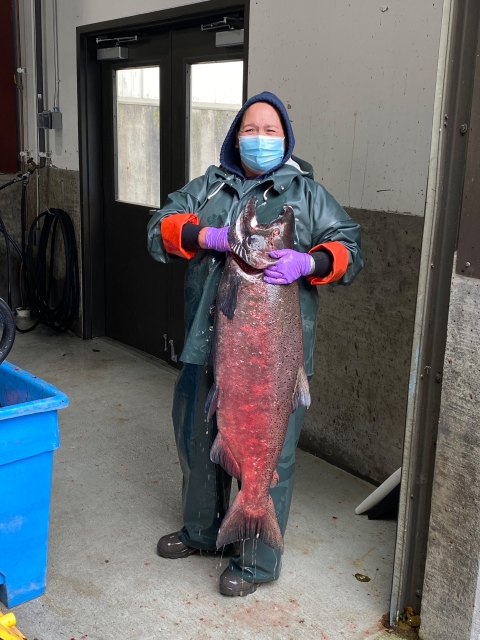What We Do
Established: 1898
Purpose & Authorizing Legislation: Little White Salmon National Fish Hatchery was established to address the decline of tule fall Chinook, the native salmon stock that returned to the Little White Salmon River. In the 1930s, the hatchery began receiving Mitchell Act funds to mitigate for habitat loss due to the completion of Bonneville Dam. The oldest hatchery on the Columbia River, it provides salmon to fulfill Tribal trust responsibilities, mitigate for lost habitat due to hydro-electric projects on the Columbia River and provide salmon for commercial and sport fisheries.
Funding: Funding is primarily provided though the Mitchell Act, administered by NOAA Fisheries. Additional funding is provided by the U.S. Army Corps of Engineers as part of the John Day/The Dalles Dam Mitigation program, and the hatchery also receives funding to produce salmon for the benefit of southern resident killer whales via the Pacific Salmon Treaty.
Fish Produced: Little White Salmon produces 1.4 million spring Chinook and 4.5 million upriver bright fall Chinook salmon for on-site release and another 1.1 million upriver brights for marking and transfer to the Yakama Nation Prosser Hatchery. Little White National Fish Hatchery also collects eggs for various federal, state, and Tribal programs, bringing the annual egg numbers to around 16.5 million.
Hatchery Life Cycle
Fall: Adult up-river bright fall Chinook (brights) return and spawning begins in mid-October. Over 16 million eggs are taken for the Little White Salmon and Willard National Fish Hatcheries and several other programs.
Winter: Eggs for both springers and brights eye up and hatch. Button-up fry are moved to raceways and fed. One year old springers start to smolt (prepare for ocean migration).
Spring: Yearling spring Chinook are released in mid-April. Young brights have their adipose fins clipped and are coded-wire tagged to provide detailed information in the marine fisheries. The fish ladder opens for adult springers about May 1.
Summer: Brights are released. Fingerling springers are fed and adult springers can be viewed in our Visitor Center while being held until spawning in late August.
Management and Conservation
The next time you go fishing, you might just catch a fish that was raised at Little White Salmon National Fish Hatchery. Since 1871, National Fish Hatcheries have been responding to conservation challenges affecting America’s fish and other aquatic species. Producing fish continues to be an irreplaceable tool in managing or restoring fisheries along with habitat conservation. In doing so, we help provide recreation opportunities to America’s 34 million anglers who spend $36 billion annually in pursuit of their favored pastime. National Fish Hatcheries raise fish and other aquatic species to help restore and sustain important fish and other aquatic species for the benefit of the American people. Hatcheries remain current by performing special studies to assure best fish culture practices.


